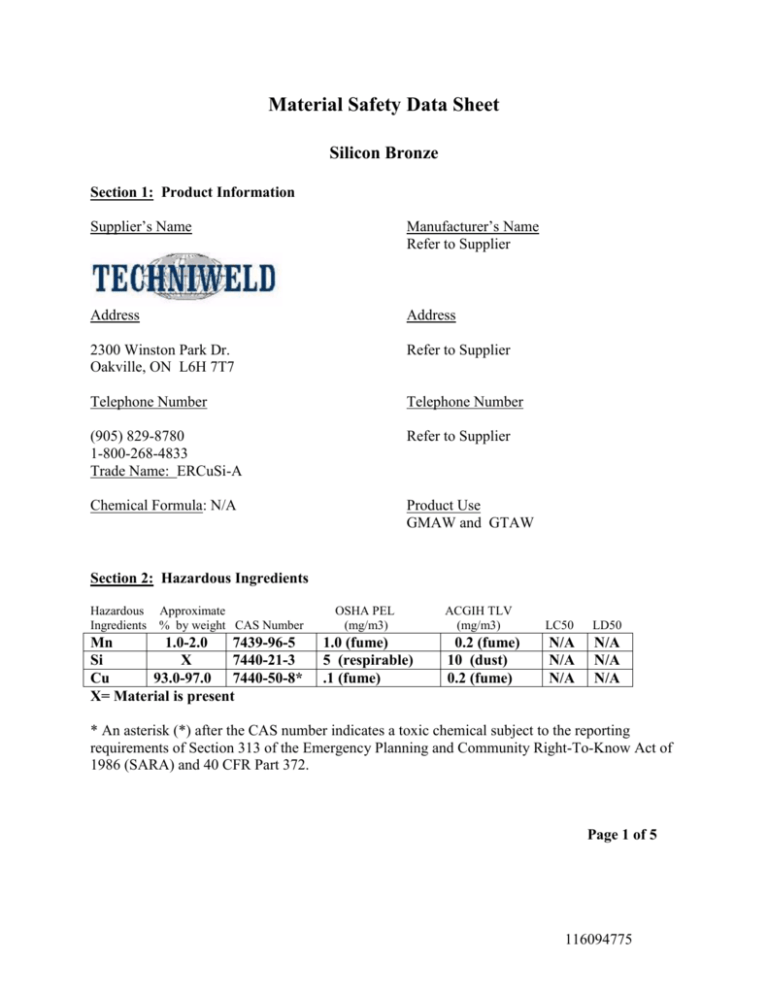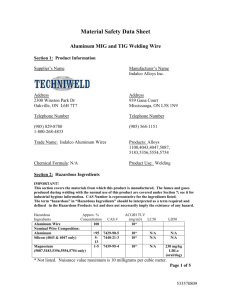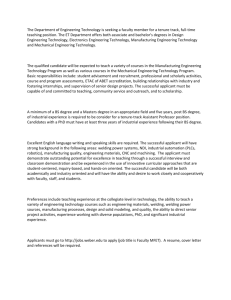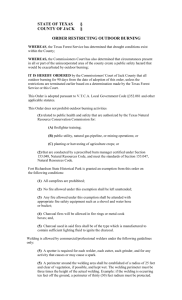Silicon Bronze MSDS () - Weld
advertisement

Material Safety Data Sheet Silicon Bronze Section 1: Product Information Supplier’s Name Manufacturer’s Name Refer to Supplier Address Address 2300 Winston Park Dr. Oakville, ON L6H 7T7 Refer to Supplier Telephone Number Telephone Number (905) 829-8780 1-800-268-4833 Trade Name: ERCuSi-A Refer to Supplier Chemical Formula: N/A Product Use GMAW and GTAW Section 2: Hazardous Ingredients Hazardous Ingredients Approximate % by weight CAS Number Mn 1.0-2.0 7439-96-5 Si X 7440-21-3 Cu 93.0-97.0 7440-50-8* X= Material is present OSHA PEL (mg/m3) 1.0 (fume) 5 (respirable) .1 (fume) ACGIH TLV (mg/m3) LC50 LD50 0.2 (fume) 10 (dust) 0.2 (fume) N/A N/A N/A N/A N/A N/A * An asterisk (*) after the CAS number indicates a toxic chemical subject to the reporting requirements of Section 313 of the Emergency Planning and Community Right-To-Know Act of 1986 (SARA) and 40 CFR Part 372. Page 1 of 5 116094775 Section 3: Physical Data Physical State: Solid. Copper based wire. Odour and Appearance: Odourless. Odour Threshold(PPM): N/A Specific Gravity: 7.4-9.0 Vapour Pressure(MM): N/A Vapour Density (Air =1): N/A Evaporation Rate: N/A Boiling Point: N/A Freezing Point: N/A Solubility in Water: N/A % Volatile (by Volume): N/A pH: N/A Coefficient of Water/Oil Distribution: N/A Section 4: Fire or Explosion Hazard Flammable: No Means of Extinction: This product will not burn; however, welding arcs and sparks can ignite combustible and flammable materials. Use the extinguishing media recommended for the burning materials and the fire situation. See ANSI Z49.1 “Safety in Welding and Cutting” and “Safe Practices” Code SP published by the American Welding Society P.O. Box 351040, Miami, Fl. 33135 and NFPA 51B “Cutting and Welding Processes” published by the National Fire Protection Association, Batterymarch Park, Quincy, MA 02269 for additional fire prevention and protection information. Flashpoint: N/A Upper Flammable Limit (% by volume): N/A Lower Flammable Limit (% by volume): N/A Auto ignition temperature: N/A Hazardous Combustion Products: N/A Explosion data-sensitivity to mechanical impact: N/A Explosion data-sensitivity to static discharge: N/A Section 5: Reactivity Data Chemical Stability: Yes Incompatibility to other substances: No Hazardous Decomposition Products: Welding fumes and gases cannot be classified simply. The composition and quantity of both are dependent upon the material being worked, the process, procedures, and consumables used. Other conditions which also influence the composition and quantity of the fumes and gases to which workers may be exposed include; coatings on the material being worked (such as paint, plating or galvanizing), the number of welding operations and the volume of the work area, the quality and amount of ventilation, the position of the welder’s head with respect to the fume plume, as well as the presence of contaminants in the atmosphere (such as chlorinated hydrocarbon vapors from cleaning or painting activities). When the materials are consumed, the fume and gas decomposition products generated are different in percent and form from the ingredients listed in Section 2. Decomposition products of normal operation include those originating from the volatilization, reaction, or oxidation or the ingredients, plus those from material being worked and the coatings, etc. noted above. Page 2 of 5 116094775 Section 5: Reactivity Data (continued) Reasonably expected decomposition products: from normal use of these products include a complex of the oxides of the materials listed in Section2 as well as carbon monoxide, carbon dioxide, ozone and nitrogen oxides (refer to “Characterization of Arc Welding Fume” available from the American Welding Society.) The fume limits for Manganese and Copper may be reached before the general limit for welding fumes of 5mg/m3 is reached. Monitor fumes for Manganese and Copper levels. The only way to determine the true identity of the decomposition products, is by sampling and analysis. The composition and quantity of the fumes and gases to which a worker may be overexposed can be determined from a sampling obtained from inside the welder’s helmet, if worn, or in the worker’s breathing zone. See ANSI/AWS F1.1 “Method for Sampling Airborne Particles Generated by Welding and Allied Processes” available from the American Welding Society. Section 6: Physical and Health Hazard Data Electric arc working may create one or more of the following health or physical hazards. Fumes and gases can be dangerous to your health. Electric shock can kill you. Arc Rays can injure the eyes and burn skin. Noise can damage hearing. An additional detailed description of the Health and Physical Hazards and their consequences may be found in free publications F52-529 “Precautions and Safe Practices for Electric Welding and Cutting” and F2035 “Precautions and Safe Practices for Gas Welding, Cutting and Heating”. You may obtain copies from your local supplier. Route of overexposure: The primary route of entry of the decomposition products is by inhalation. Skin contact, eye contact and ingestion are possible. Absorption by skin contact is unlikely. When these products are used as recommended and ventilation maintains exposure to the decomposition products below the limits recommended in this section, overexposure is unlikely. Effects of Acute (short term) overexposure to the gases, fumes and dusts may include irritation of the eyes, lungs, nose and throat. Some toxic gases associated with welding may cause pulmonary edema, asphyxiation and death. Acute overexposure may include signs and symptoms such as watery eyes, nose and throat irritation, headache, dizziness, difficulty in breathing, frequent coughing, or chest pain. . Pre-existing Medical Conditions Aggravated by Overexposure: Individuals with allergies or impaired respiratory function may have symptoms worsened by exposure to welding fumes; however, such reaction cannot be predicted due to the variation in composition and quantity of the decomposition products. Page 3 of 5 116094775 Section 6: Physical and Health Hazard Data (continued) Effects of Chronic (long term) overexposure: to air contaminants may lead to their accumulation in the lungs, a condition may be seen as dense areas on chest x-rays. The severity of the change is proportional to the length of the exposure. The changes seen are not necessarily associated with symptoms or signs of reduced lung function or disease. In addition, the changes on x-rays may be caused by non-work factors such as smoking, etc. Overexposure to manganese compounds may affect the central nervous system, symptoms of which are languor, sleepiness, muscular weakness, emotional disturbances, and spastic gait. Exposure Limits for the ingredients are listed in Section 2. The 1989 OSHA TWA for welding fume is 5mg/m3. TLV-TWA’s should be used a s a guide in the control of health hazards and not as fine line between safe and excessive concentrations. When these products are used as recommended by the manufacturer, and the preventive measures taught in this MSDS are followed, overexposure to hazardous substances will not occur. Exposure Limits Irritancy of Material Sensitization to Material Carcinogenity 5 mg/m3 N/A N/A No Reproductive Toxicity Teratogenicity Mutagenicity Toxicologically synergistic products N/A N/A N/A N/A Section 7: Preventive Measures Read and understand the manufacturer’s instructions and the precautionary label on this product. See American National Standard Z-49.1 “Safety in Welding and Cutting” published by the American Welding Society P.O. Box 351040, Miami, FL 33135 and OSHA publication 2206 (29C.F.R. 1910) U.S. Government Printing Office, Superintendent of Documents, P.O. Box 371954, Pittsburgh, PA 15250-7954 for more detail on many of the following: Personal Protective Equipment: Respiratory Protection: Use respirable fume respirator or air supplied respirator when welding in confined space or where local exhaust or ventilation does not keep exposure below TLV. Eye Protection: Wear helmet or use face shield with filter lens. As a rule of thumb, start with a shade which is too dark to see in the weld zone. Then, go to the next lighter shade that gives sufficient view of the weld zone. Provide protective screens and flash goggles, if necessary to shield others. Protective Clothing: Wear head, hand, and body protection that help to prevent injury from radiation, sparks and electrical shock. See ANSI Z-49.1. At a minimum, this includes welder’s gloves and protective face shield and may include arm protectors, aprons, hats, shoulder protection, a well as dark substantial clothing. Train the welder not to touch live electrical parts and to insulate himself from work and ground. Page 4 of 5 116094775 Section 7: Preventive Measures (continued) Engineering Controls: Ventilation: Use enough ventilation, local exhaust at the arc or both to keep the fumes and gases below the TLV’s in the worker’s breathing zone and the general area. Train the welder to keep his head out of the fumes. Leak or Spill Procedure: N/A Handling Procedures and Equipment: N/A Waste Disposal: Prevent waste from contaminating surrounding environment. Discard any product, residue, disposable container, or liner, in an environmentally acceptable manner in full compliance with local, provincial and federal regulations. Storage Requirements: N/A Special Shipping Information: N/A Section 8: First Aid Measures In case of an emergency, call for medical aid. Employ first aid technique recommended by the Canadian Red Cross. If breathing is difficult, give oxygen and call for a physician. For electric shock, disconnect and turn off the power. If not breathing, begin artificial respiration, preferably mouth-to-mouth. If no detectable pulse, begin Cardio Pulmonary Resuscitation (CPR). Immediately call a physician. For Arc Burn, apply cold, clean compresses and call a physician. Section 9: Preparation Information Prepared by: Techniweld (905) 829-8780 1-800-268-4833 Date Prepared: January 1, 2015 The manufacturer believes this data to be accurate and to reflect qualified expert opinion regarding current research. However, the manufacturer cannot make any express or implied warranty as to this information Page 5 of 5 116094775








